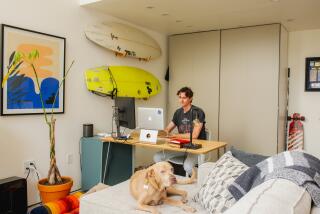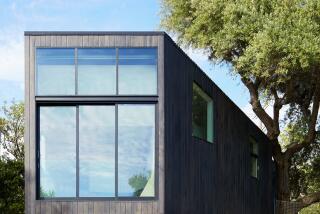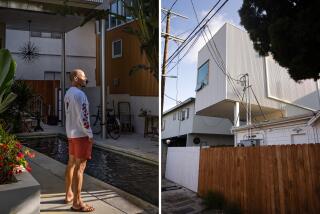An Experiment in Efficiency
- Share via
This house is an opportunity to practice what I preach,” says architect David Hertz, who teaches a course on the ecology of architecture at UCLA. Known for using recycled and environmentally safe building materials, Hertz sees his recently completed home in Venice “as a working experiment to test and live with concepts I believe in.”
Instead of installing conventional air conditioning, for example, Hertz developed an elaborate system of windows, front and rear, to take advantage of the coastal location by capturing and circulating cool ocean breezes throughout the rooms. Strategically placed electric skylights open and close automatically to allow hot air to escape. “If it rains, they close. If it gets too hot, they open,” Hertz says. “You don’t have to be here for them to work.”
To heat the house, Hertz recycled a solar panel from an old commercial building. Radiant heat from water warmed by the panel circulates through tubes to heat the concrete slab floors as well as tubs, the built-in living room bench and the main south-facing wall that cuts through the house. “It may look like a cold surface, but it’s warm,” Hertz says of the floor, which ranges in temperature between 65 and 72 degrees Fahrenheit. By forgoing a forced-air heating system, he also gained 21/2 feet of ceiling space and eliminated ducting and attic space where dust and mold love to grow.
Inside and out, the home features products fashioned from recycled materials. Countertops, sinks, tubs and fireplaces are made of Syndecrete, a lightweight concrete Hertz developed out of 50% recycled materials, which can include decorative machine parts, bottle glass and ground-up vinyl records. Colorful sample tiles from his Syndesis showroom line the parkway. Wood forms used for poured-in-place concrete were dismantled and turned into the downstairs front deck. “Wherever I could,” he explains, “I tried to use construction waste, especially wood.”
Hertz also wanted a nontoxic environment for his wife, Stacy, and their three young children. “Even though people spend 80% to 90% of their time indoors, we are just on the threshold of improving indoor air quality,” says Hertz, who often speaks publicly on air-quality issues. To that end, he chose zero-VOC (volatile organic compounds) interior paint, which emits no pollutants. And instead of solvents, he went with natural linseed and tung oils on exposed wood beams. Finally, Hertz opted for burnished concrete floors instead of carpet, which can also harbor unwanted mold. The surface, as it turns out, has another bonus. “The kids ride their bicycles on it,” he says. “And if they spill something, we can hose it off right out the front door.”
More to Read
Sign up for Essential California
The most important California stories and recommendations in your inbox every morning.
You may occasionally receive promotional content from the Los Angeles Times.






